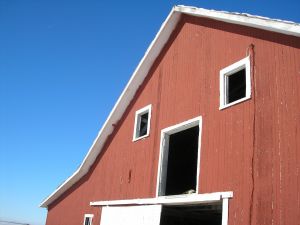When you drive through farmlands and rural areas, you’ll notice that most barns are painted red. But why red? Why not simply white like most of the farmhouses or maybe even brown? What’s so special about the color red anyway that it has become the quintessential color of barns?
Linseed Oil Use
Before the invention of paints with special properties that can protect and seal wood, there was the use of linseed oil. Linseed oil, a yellowish-brown colored oil, came from the flax plant, specifically its seed. The oil is mixed with other ingredients like lime as well as milk. This mixture, when painted over wood, quickly dries up and hardens to provide the wood a protective covering that also seals up the holes. The linseed oil worked well to protect the barn against the different weather conditions. However, it cannot protect the building that well against mold, mildew, fungi, and moss, which typically grows on wood.

The Color Red
There are two common theories as to why barns are red:
- Aside from the linseed oil, milk, and lime mixture, the farmers also add blood from slaughtered cows into the oil mixture. As the mixture dries up, the blood will lend the structure a reddish-brown to burnt red color. Some say that farmers add blood to the mixture to “show off” their wealth or to simulate the color of brick.
- Another reason why barns are red is because the farmers make use of ferrous oxide or, in layman’s term, rust. Rust is considered to be toxic to mold and mildew as well as fungi and moss. Because rust is plentiful in farms, the farmers add rust into the oil mixture, protecting the barn not only against the different weather conditions but also against mold, mildew, fungi, and moss.
Aside from protection and sealant, the color red also has a lot of benefits. For one, the dark color red traps heat, so this keeps the barn warmer come the winter season. Two, when paint was invented, red paint was the cheapest to buy. It was even cheaper than whitewash paint, which was commonly used for farmhouses. Because of these, red became the traditional color of barns.
Modern Barns
Nowadays though, barns are no longer just red. When you drive through farmlands and rural areas, you will see barns of different colors such as black, green, brown, white, among others. However, the predominant color will always be red because red barns have become a part of our tradition.
Barns are also no longer just wood since there are metal barns nowadays. The popularity of metal barns is growing yearly as more and more farmers are making use of metal structures in their farms. Not only are metal barns more durable and lasts longer than wooden barns, but in the long run, they’re also more cost effective, allowing them to save huge amounts of cash in electric bills. Aside from this, metal barns also need less maintenance. This means that farmers can focus more on other important farm matters than giving it regular maintenance like replacing rotten wood, repainting them, and resealing wood, etc., which traditional wooden barns need.
You need not worry about aesthetics, too, because there are also metal barns painted the quintessential color of red.
Citations:
- http://www.sxc.hu
Jennifer Dalcour is a freelance provider for construction companies such as Coast to Coast Carports, Inc. a known provider of metal structures such as metal barns, metal garages, and metal carports. She writes mostly about the importance and benefit of metal buildings compared to traditional ones.

